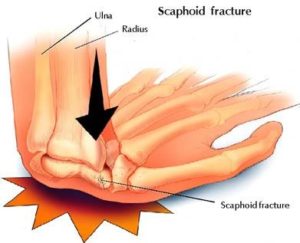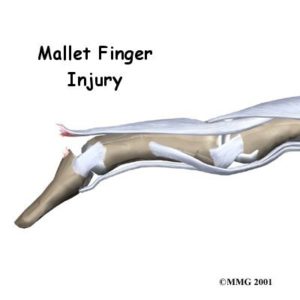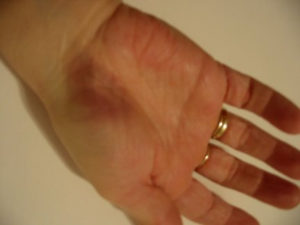Traumatic Injuries of Hand
Fractures
Fractures occur when a force is strong enough to crack the bone. This typically occurs with a fall onto the hand, when the hand jams or impacts a hard object, when the hand is crushed between objects, or if the hand is forcefully twisted. A broken bone is not worse than a fractured bone; the two terms are considered to be synonymous. A bone is considered to be fractured whether it has a hairline crack or a large break with the two pieces of bones displaced.
If you feel you have broken a bone, seek medical attention immediately. Symptoms may include rapid swelling, tenderness, and bony deformity. If bone has broken through the skin, it is imperative that you see a doctor as soon as possible because the risk of infection may be high.
X-rays will be taken to verify the fracture location, type and severity. The bones will need to be stabilized in some method until the body is able to create a bony bridge to hold the pieces of broken bone together. When given enough time to heal, this bony bridge is quite strong (some people feel it is even stronger than the healthy bone) and is able to withstand all normal activity. (See related video under the post)
If the fracture is fairly stable, the break may need only a cast to provide the immobilization needed for healing. Casts are typically worn from 6-8 weeks after a fracture. Please see cast wear for cast tips.
If the fracture is not stable and the bones may slip, the doctor may need to perform a surgery to place an internal stabilization device (such as pins, screws or plates). The benefits are that the bones will heal in a better anatomical position and they are now stable enough to begin earlier movement in order to minimize stiffness. Unfortunately, the surgery also introduces scar tissue. Please see scar management for tips to minimize scarring.
The most commonly fractured wrist bone is the radius (a distal radius fracture). The fracture occurs at the base of one of the two long forearm bones that make up the forearm. The radius is the bone on the thumb side of the forearm and the fracture occurs close to the wrist. Depending upon the position of the broken bone, either displaced to the palm or the back side of the hand, this may be called either a Colles’ or a Smith’s fracture.
 A scaphoid fracture occurs in one of the small wrist bones (carpal bones) where the thumb base meets the wrist. This bone does not have a good blood supply and heals slowly. Casting time for a scaphoid fracture can be lengthy (3 months or longer) and the rate of the bones not healing is greater than for other bones. In extreme cases, If the bones are not healing, the doctor may recommend a bone stimulator be used, or you may need a bone graft to promote healing. If you have been diagnosed with a scaphoid fracture, follow-up with your doctor diligently.
A scaphoid fracture occurs in one of the small wrist bones (carpal bones) where the thumb base meets the wrist. This bone does not have a good blood supply and heals slowly. Casting time for a scaphoid fracture can be lengthy (3 months or longer) and the rate of the bones not healing is greater than for other bones. In extreme cases, If the bones are not healing, the doctor may recommend a bone stimulator be used, or you may need a bone graft to promote healing. If you have been diagnosed with a scaphoid fracture, follow-up with your doctor diligently.
Commonly occurring hand fractures include a boxer’s fracture (a break in the long bones of the finger, the metacarpal bone, when a closed fist impacts an object) or a phalanx fracture.
 A mallet finger is a fracture of the small end bone of the finger (the distal phalanx) on which a tendon is attached that pulls the finger tip straight. When the bone chips, the tendon does not have the base on which to pull the tip straight and the finger tip droops. The doctor will recommend that the tip be splinted straight for 8 weeks until the bone fuses and enough scar tissue forms that the tendon works the way it should. It is important to keep the tip straight at all times during the splinting period. If you bend the finger tip at all (many people want to “test” it), the healing tissue is damaged and you will need to start the 8 weeks over again.
A mallet finger is a fracture of the small end bone of the finger (the distal phalanx) on which a tendon is attached that pulls the finger tip straight. When the bone chips, the tendon does not have the base on which to pull the tip straight and the finger tip droops. The doctor will recommend that the tip be splinted straight for 8 weeks until the bone fuses and enough scar tissue forms that the tendon works the way it should. It is important to keep the tip straight at all times during the splinting period. If you bend the finger tip at all (many people want to “test” it), the healing tissue is damaged and you will need to start the 8 weeks over again.
Fracture Tips
- Wear the cast or splint as your doctor or therapist advises.
- If you have any painful areas, pressure spots or excessive tightness, let the doctor or therapist know so that the splint or cast can be modified.
- Let your doctor or therapist know if the cast or splint is cutting off circulation.
- Keep any joints that are not immobilized loose. Too often, uninvolved joints, such as the shoulder, can become tight.
- Do not get the cast wet. Use plastic bags to keep it dry during showering activity. Do not go swimming when you are in a cast.
- Do not try to scratch an itch by placing a coat hanger or any sharp object into the cast.
- Do not perform strenuous exercise or use the arm for heavy lifting while a fracture is healing. This can stress the injured area even if it is casted.
- Use uninjured joints as naturally as possible for lighter activity.
- Use cold packs to control swelling in areas that are not covered by the cast.
- Keep the injured arm elevated to control swelling.
- Eat a healthy diet and stop smoking to help with injury recovery.
Bruises and Contusions
A bruise or a contusion occurs due to a direct blow to the hand. This often occurs during sports related activity or with a crushing injury around machinery. The hand or injured area may initially become swollen and red, the tissues may feel firm or hard, the area will be tender and may be quite painful, and it may be difficult or painful to move surrounding joints. The bruising is caused by bleeding in the tissues due to broken capillaries. The discoloration will change to the more typical purplish, greenish, yellowish coloration with time.
Contusion Tips
- Use cold packs to control swelling.
- Keep arm elevated as needed to control swelling.
- Use an ace wrap or support for gentle compression if needed.
- Keep the uninjured joints flexible and begin gently moving the injured joints as soon as pain and swelling allow.
- Eat a healthy diet and stop smoking to help with injury recovery.
Related Video:
